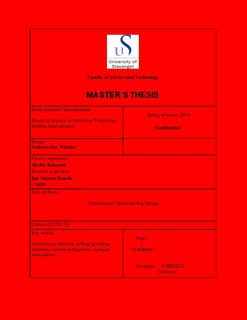| dc.contributor.author | Winther, Andreas Ims | |
| dc.date.accessioned | 2014-12-17T13:10:49Z | |
| dc.date.available | 2014-12-17T13:10:49Z | |
| dc.date.issued | 2014-06-12 | |
| dc.identifier.uri | http://hdl.handle.net/11250/227644 | |
| dc.description | Master's thesis in Petroleum engineering | nb_NO |
| dc.description.abstract | Increasing the number of wells drilled into a reservoir leaves less oil in the reservoir as well as exploration of new reservoirs demands to drill new wells. By increasing the efficiency of a drilling rig, more wells can be drilled for the same cost, which brings more oil to the surface. The overall goal of a drilling rig is to have weight on bit, cutting new formation, which is regarded as the Productive Time (PT), referring to reference [1]. To reduce the Non-Productive Time (NPT), the efficiency of the machines and their configuration needs to be evaluated in an efficient way in the design phase of a drilling rig.
Tripping constitutes 20-30% of the total time while operating a drilling rig [2]. Tripping demand no weight on bit, thus this time will be part of the NPT. By reducing the duration of tripping one stand, the efficiency of a drilling rig is increased.
MicroSoft Project (MS Project) is evaluated to be a program with functionalities of great value to evaluate and decrease the duration of an activity, e.g. tripping in. Several operations constitute an activity and the goal is to make the sequence of operations as efficient as possible.
To decrease the duration of an activity, machines and their operations should aim to be executed simultaneously, with short trajectories/distances to travel and high, but safe velocities. The sequence of operations in an activity is restricted by dependencies between the operations that define which operations that can be run simultaneously.
The critical path in MS Project consists of the critical operations with no slack, and defines the duration of an activity. The goal is to set up the correct dependencies and the duration for each operation in an activity to find the critical operations. These critical operations will be the bottlenecks and therefore the operations and machines to improve.
For Rig 1 it is evaluated to be possible to decrease the duration of tripping in one stand from 124 seconds to 104 seconds. Instead of tripping 29 stands per hour it should be equipped with a faster hoisting system which make it possible to trip 34,6 stands per hour.
Even though well parameters allow high velocities lowering the drillstring into the well, the machine configuration may restrict to decrease the duration of tripping in one stand by increasing the velocity of the operation “Lower to stickup”. In that case the machine configuration is the limiting factor.
A lot of the machines on a drilling rig are driven by hydraulic pressure. The department Drilling Systems has been asked to evaluate the requirements for the Hydraulic Power Unit (HPU). They need to evaluate the total flow required [l/min] of hydraulic oil at the time of highest consumption. Each consumer of the hydraulic oil as hydraulic motor(s) and/or cylinder(s) demand a flow [l/min] to operate as intended. The sequence of consumers is a result of the sequence of operations. After the sequence of operations is optimized and illustrated in a Gantt chart, it can be broken down to a level which illustrates the sequence of consumers through the activity. The sequence of consumers and the flow needed to each consumer results in the hydraulic flow through the activity. The activities evaluated to take place at the same time may coincide such that the maximum flow in each activity must be added to determine the flow required from the HPU. | nb_NO |
| dc.language.iso | eng | nb_NO |
| dc.publisher | University of Stavanger, Norway | nb_NO |
| dc.relation.ispartofseries | Masteroppgave/UIS-TN-IPT/2014; | |
| dc.rights | Attribution-NonCommercial-NoDerivs 3.0 Norway | * |
| dc.rights.uri | http://creativecommons.org/licenses/by-nc-nd/3.0/no/ | * |
| dc.subject | petroleumsteknologi | nb_NO |
| dc.subject | boreteknologi | nb_NO |
| dc.title | Performance optimized rig design | nb_NO |
| dc.type | Master thesis | nb_NO |
| dc.subject.nsi | VDP::Technology: 500::Rock and petroleum disciplines: 510::Petroleum engineering: 512 | nb_NO |

